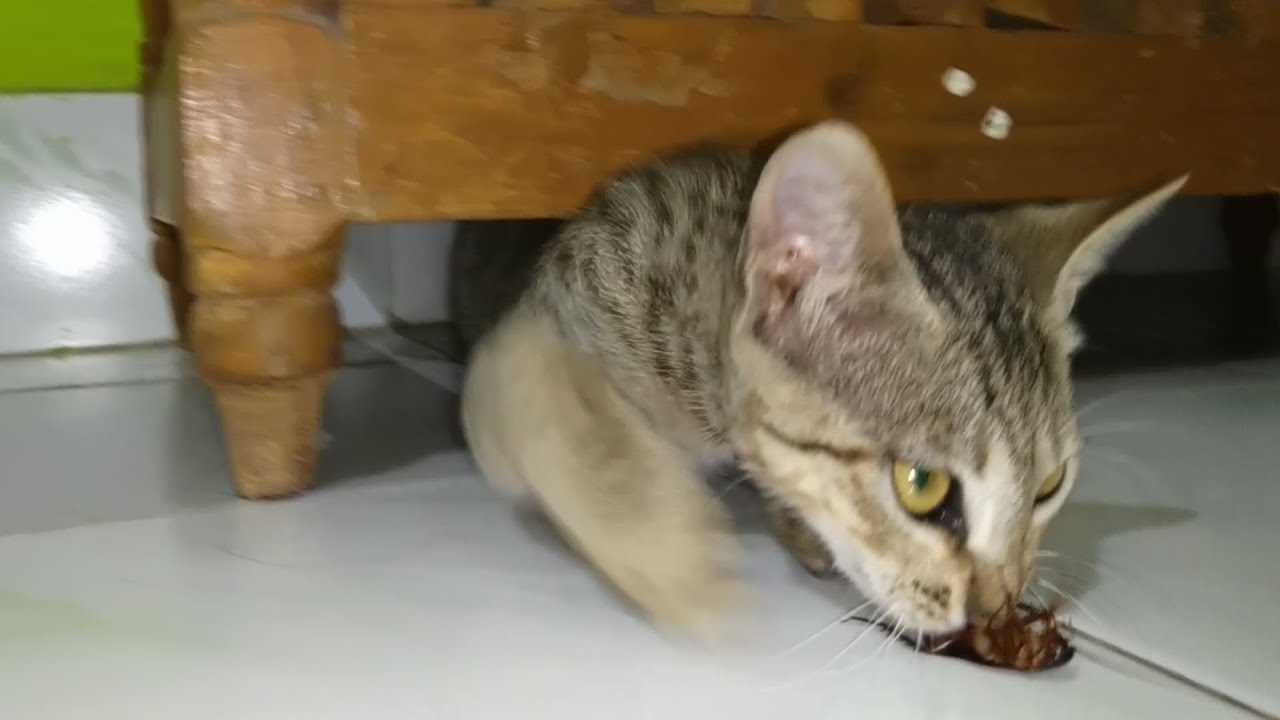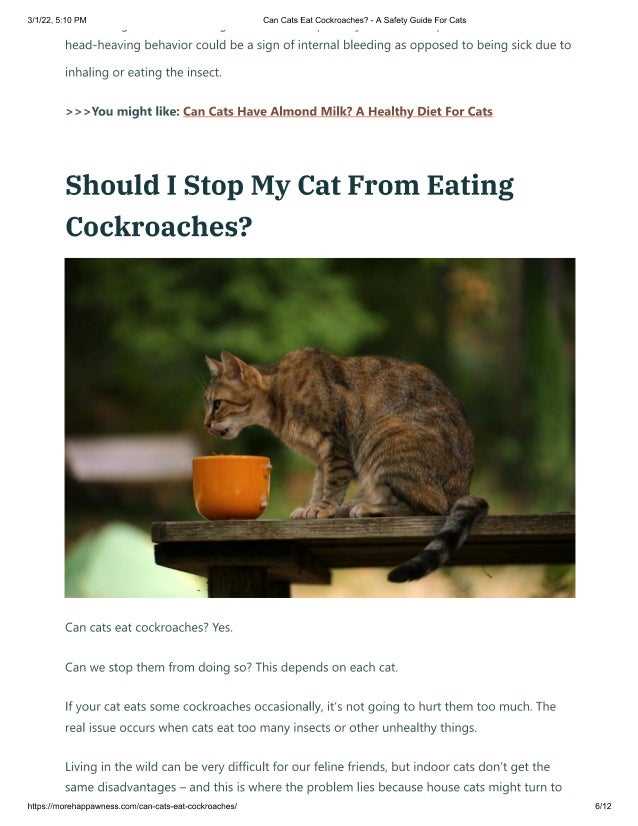



It’s all about instinct and curiosity! As a playful feline, I often find myself exploring my surroundings, and those little critters can be quite intriguing. Their movement catches my eye, and my natural hunting instincts kick in. This behavior isn’t just random; it’s a part of who I am.
In addition to being fun to chase, these insects offer a source of protein. While I have a balanced diet provided by my human, the occasional crunchy snack can be tempting. It’s a throwback to my wild ancestors, who relied on similar sources of nutrition. I can’t help but indulge every now and then!
If my human is concerned about my snacking habits, they should ensure that I have plenty of playtime and engaging toys. Keeping me entertained reduces the likelihood of me targeting those little pests. After all, a well-stimulated kitty is a happy kitty!
Understanding Your Feline’s Natural Hunting Instincts
Engaging in play that mimics the act of capturing prey is vital. Utilize toys that resemble insects or small creatures to stimulate instincts. Consider feather wands, laser pointers, or toys that move unpredictably.
Setting a hunting environment enhances the experience. Create spaces where your furry friend can stalk and pounce. Use boxes, crumpled paper, or tunnels to foster a sense of adventure.
- Rotate toys regularly to maintain interest.
- Encourage exploration by hiding treats in different areas.
- Incorporate puzzle feeders to combine play with mealtime.
Understanding how instinct manifests is key. Observe behaviors such as stalking, pouncing, and batting at objects. These actions are not just for fun; they reflect innate skills honed over generations.
Limit distractions during playtime. A quiet environment allows for focus and enhances the hunting experience. This can help channel energy in a productive way.
Regular play sessions are crucial. Aim for at least 15-30 minutes daily to keep your companion physically and mentally stimulated. This practice can reduce stress and prevent unwanted behaviors.
Recognize that instincts can lead to capturing unintended targets. Being aware of this can help in managing what’s available in the home environment to ensure safety and well-being.
Assessing the Nutritional Value of Cockroaches for Cats
Crunchy little critters offer a surprising array of nutrients beneficial for felines. High in protein, these insects can provide around 60-70% protein content, which is essential for muscle development and energy. Furthermore, they pack healthy fats, contributing to a balanced diet.
Key Nutrients Found in Cockroaches

Among the vital components, you’ll find amino acids, which are building blocks for a strong and healthy body. Additionally, cockroaches contain vitamins like B12, supporting metabolic functions and overall vitality. Minerals such as calcium and phosphorus are also present, promoting bone health.
Considerations for Insect Consumption
While munching on these little bugs can be beneficial, it’s crucial to ensure they are sourced safely. Wild insects may carry pesticides or toxins, which could harm health. Instead, consider alternatives like canned chicken for cats, which provide a safer protein source. Always monitor how your furry friend reacts to new food items, ensuring a happy and healthy diet.
Identifying Signs of Pest Infestation in Your Home

Look for droppings in hidden areas, especially in kitchens and bathrooms. Small, dark pellets can indicate the presence of unwanted insects. Keep an eye out for discarded exoskeletons, which signal recent molting. If you spot these, it’s time to investigate further.
Unusual odors may arise from nesting sites. A musty or foul smell could mean a colony is nearby. Pay attention to strange noises at night; scurrying sounds can hint at nighttime activity from critters. Don’t ignore any unexplained scratches or gnaw marks on furniture or walls, as these can point to a larger problem.
Check for signs of damage to food packaging. If you find holes or chew marks, these are clear indicators that something is trying to access your pantry. Also, observe for greasy smudges along walls or surfaces; these can be left behind by pests traveling through your space.
Set up traps in strategic locations. If you catch anything, it’s a strong signal to take action. Regularly inspect your home for entry points; even tiny gaps can let in unwanted guests. Sealing cracks and crevices can deter many intruders.
Monitor your pet’s behavior. If they’re suddenly fixated on certain areas, it may suggest a hidden presence. Their instincts can often alert you to problems before they become serious.
Exploring Potential Health Risks of Cats Eating Cockroaches
I recommend monitoring any encounters with these insects closely. While it might seem harmless, consuming them can lead to health issues. The primary concern is the possibility of parasites. Certain types can carry worms or other parasites that may infect me.
In addition, these creatures can harbor bacteria, potentially causing gastrointestinal upset. Symptoms like vomiting or diarrhea may arise after ingesting contaminated prey. It’s wise to observe for any signs of distress following such meals.
Another factor to consider is the potential exposure to pesticides. Homes treated with chemicals to eliminate pests could pose serious risks. If I consume a bug exposed to these substances, it could result in toxicity. Regularly check for any signs of chemical treatments in your environment.
Lastly, allergic reactions can occur. Some of us may develop sensitivities to proteins found in these insects, leading to skin irritations or respiratory issues. If I show any unusual symptoms, a visit to the vet is essential.
Maintaining a safe environment is key. Regular cleaning and pest control can help minimize risks while allowing me to indulge my hunting instincts without harm.
Strategies to Discourage Your Feline Friend from Consuming Insects
Implementing preventive measures is key. Start by sealing entry points in your home. Inspect windows, doors, and any cracks where unwanted creatures might sneak in.
Maintaining cleanliness is paramount. Regularly clean food spills and crumbs to eliminate attracting pests. Vacuuming frequently can also help, as it removes potential hiding spots.
Utilizing deterrents can be effective. Consider natural repellents like essential oils that are safe for pets, such as peppermint or citrus, which can help keep insects at bay.
Creating a stimulating environment is beneficial. Provide plenty of toys and interactive playtime to channel hunting instincts towards appropriate targets. This can reduce the interest in uninvited guests.
Monitoring the behavior of your companion is crucial. If you notice a persistent focus on hunting, consult with a veterinarian for advice tailored to your situation.
| Strategy | Description |
|---|---|
| Seal Entry Points | Inspect and close any gaps in your home to prevent pests from entering. |
| Regular Cleaning | Keep surfaces free from food debris that may attract insects. |
| Natural Deterrents | Use pet-safe essential oils as natural repellents against unwanted creatures. |
| Interactive Playtime | Provide toys and activities to engage your buddy and satisfy their hunting drive. |
| Behavior Monitoring | Keep an eye on behavior; seek veterinary advice if necessary. |
For those needing outdoor cleaning solutions, check out the best polyurethane pressure washer hose to keep your space tidy.
FAQ:
Why does my cat seem to enjoy eating cockroaches?
Cats are natural hunters, and their instincts often drive them to chase and catch small creatures, including insects like cockroaches. The movement of these pests can trigger their predatory behavior. Additionally, some cats may find the taste or texture of cockroaches appealing, especially if they are curious or bored. It’s essential, however, to monitor your cat’s health, as eating insects can sometimes lead to stomach upset or other issues.
Should I be concerned if my cat is eating cockroaches?
While it’s not uncommon for cats to eat insects, including cockroaches, there are a few concerns to keep in mind. Cockroaches can carry diseases and parasites that may affect your cat’s health. If your cat consumes a significant number of them or shows signs of illness, such as vomiting, lethargy, or changes in appetite, it’s a good idea to consult a veterinarian. Additionally, ensuring your home is free of cockroaches is beneficial for both your cat’s health and your living environment.










